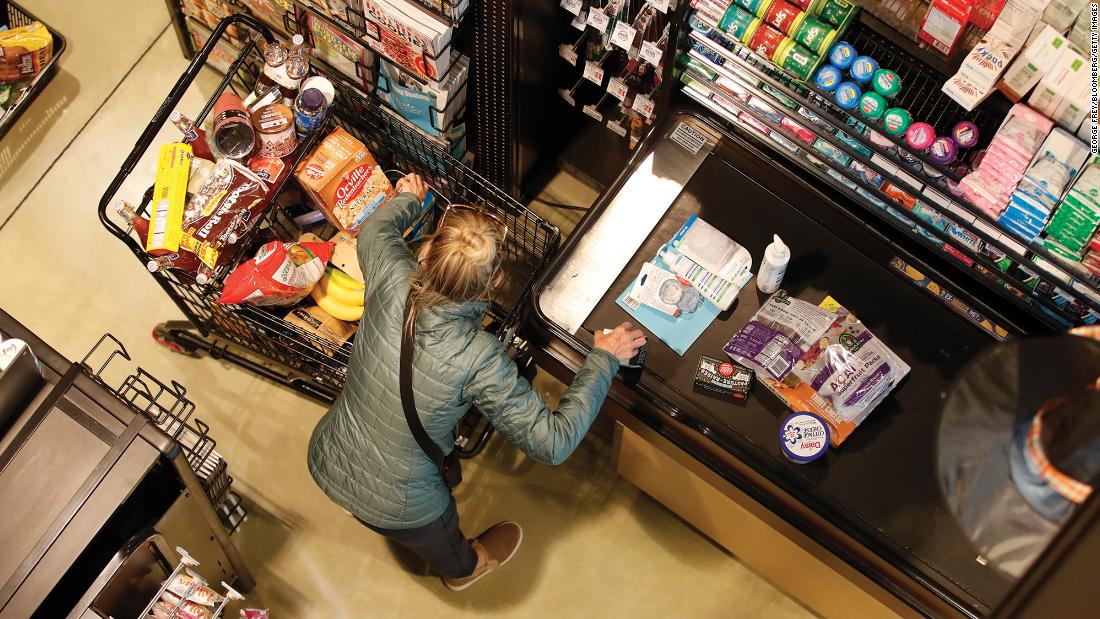Inflation in the US could worsen, warns Goldman Sachs 0:53
New York (CNN Business) -
You've probably noticed that shopping for groceries and basic household items is more expensive these days.
And he hopes to continue paying more for food in 2022.
The prices that shoppers paid for groceries rose 1% in October from September and were 5.4% higher than in the same period last year, according to data released Wednesday by the Bureau of Labor Statistics.
Overall, prices, which also include things like rent, cars and energy, are up 6.2% in the past 12 months, the biggest increase since 1990.
Within supermarkets, steaks have seen the highest price increase annually, costing 24.9% more in October than a year ago.
Eggs were 11.6% more expensive in October than a year ago, chicken cost 8.8% more, cereals 5% more, and baby food prices grew 7.9% annually.
US: Soft drinks, tortillas and meat rise sharply in price due to supply chain crisis
Why are prices rising and how long will it last?
Grocery prices stagnated from 2015 to 2019, but have risen during the pandemic.
In 2020, grocery prices increased 3.7% over the previous year.
Food manufacturers and supermarkets have faced higher costs for commodities, labor, transportation, and other expenses during the pandemic.
Those costs have risen in recent months, prompting manufacturers to pass some of these costs on to their retail customers, who in turn have passed a portion on to consumers.
advertising
The producer price index, which measures the price manufacturers receive for their goods and services, rose 0.6% last month from September and rose 8.6% year-on-year.
ANALYSIS |
Why inflation is a political nightmare for Biden
Lingering supply chain pressures mean higher prices at the grocery store are likely to stick around for a while.
Large makers of family-owned food and household staples brands such as Kraft Heinz, Mondelez, Procter & Gamble, Clorox, and Tyson Foods say they plan to raise prices for snacks, toiletries, meat and more for their retail customers to early 2022 to combat rising costs.
Companies are also reducing discounts on many items in stores because demand is strong and they don't want to run out of their limited supplies of goods.
"We continue to face accelerating levels of extraordinary inflation," Tyson said in a letter to retail customers last month in which he announced that he would increase prices next year on brands such as Ball Park hot dogs and Jimmy Dean frozen breakfast.
"The sustained duration and significant impact of inflation require additional price action."
"We've been raising prices and plan to raise prices more than we have ... for quite some time as a company," Mondelez CEO Dirk Van de Put said in an earnings call with analysts last week. .
Mondelez makes brands like Oreo and Chips Ahoy.
Van de Put said that a price increase of 6% to 7% will take effect on its US products in January.
Market research firm IRI projects that inflation in food, beverages and household staples will rise to 8% during the first half of 2022 before settling at 4% during the second half of the year.
IRI tracks prices, point of sale and volume data, promotions and trends in department stores, wholesale clubs, supermarkets, pharmacies and other channels.
The firm also consults with some of the largest US retailers and brand manufacturers and conducts consumer surveys.
China has a serious inflation problem that drives prices up around the world
Squeeze low-income customers
While higher food prices are affecting families across the country, low-income shoppers are hit the hardest when staples become more expensive.
These consumers have less disposable income and already spend more of their wallet on commodities than wealthier consumers.
"Families who have to spend a greater proportion of their income on basic necessities are more squeezed when prices for basic necessities rise," Diane Whitmore Schanzenbach, director of the Northwestern University Policy Research Institute, said in an email. recent electronic.
According to 2019 data, the latest available, households in the lowest income group spent an average of US $ 4,400 on food, which represents 36% of their income, while households in the highest income segment spent an average of $ 4,400 on food. an average of US $ 13,987 in food, which represents 8% of income, according to the Department of Agriculture.
Despite the price hikes, a recent increase in federal benefits, such as food stamps, as well as the child tax credit, along with higher wages, can help low-income buyers handle the hikes.
An increase in federal food stamps can help alleviate some cost pressures for shoppers in the Supplemental Supplemental Nutrition Assistance Program (SNAP).
More than 41 million people signed up for the program in July, according to the most recent data from the Department of Agriculture.
The Fed warns that problems in China's real estate sector could affect world markets and the US economy.
Profits as of October increased 27% above pre-pandemic levels, on average, the largest increase in the program's history.
The change is due to a review of the Thrifty Food Plan, which determines benefit amounts for SNAP recipients.
The update is part of a U.S. Department of Agriculture review of the food stamp program required by the 2018 Farm Bill.
The average monthly benefit will increase to $ 169 per person under review, according to the agency, compared to $ 121 per person before the coronavirus pandemic.
Low-wage workers are also benefiting from "staggering" increases in the tight labor market, according to Goldman Sachs.
Pay for low-wage workers rose 5.3% annually during the second quarter of the year, the bank said in a report last month.
And the enhanced child tax credit, which gives families up to $ 3,600 a year for each child up to age 6 and $ 3,000 for each child ages 6 to 17, has helped families pay higher prices. high.
What does it mean for shoppers and stores?
Consumers have shown a willingness to accept higher prices for food and basic household items without a large decrease in spending.
That may not last much longer.
In 2007, 2008 and 2011, prices increased more than 5% in groceries, resulting in a decrease in volume (buyers bought less of a product or switched to a cheaper version), according to IRI.
The firm projects this to happen in 2022, with a volume drop of up to 5% compared to this year.
The United States added 531,000 jobs to the economy in October
IRI says customers are starting to decline in the areas of the store where prices have risen the most.
"Buyers are paying more for some categories, like meat, and are starting to opt for cheaper alternatives," said Krishnakumar Davey, president of IRI's strategic analysis practice.
Some shoppers are switching from premium cuts like rib-eye, sirloin and tenderloin to ground beef, ground turkey and ground lamb, according to IRI point-of-sale data and conversations with grocers and manufacturers.
Higher grocery bills can benefit discount stores at the expense of full-price supermarkets.
When prices in customers' regular stores become unaffordable, they are more willing to look for cheaper ones.
That may boost companies like Walmart, Dollar General, Aldi and other discount chains that cater in part to low-income shoppers, analysts say.
What are the main products affected by the crisis in the supply chain?
Grocery Outlet, a discount supermarket, expects inflation to push more shoppers to its inexpensive stores.
Consumers "notice the higher prices a lot" and "increasingly they are something that will make them change patterns or look for ways to save money," CEO Eric Lindberg said on an earnings conference call with analysts on Tuesday.
"We believe that ultimately this turns out to be in our favor."
CNN's Tami Luhby contributed to this article.
Inflation








/cloudfront-eu-central-1.images.arcpublishing.com/prisa/I5QVHIQITJED5JXFONRYR33O2I.jpg)
